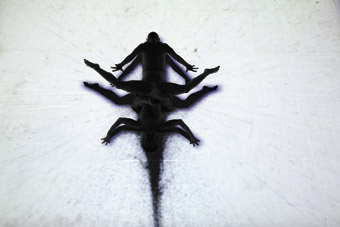a feral universe
keith gallasch transported by chunky move’s mortal engine

Mortal Engine, Chunky Move
photo Rom Anthonis
Mortal Engine, Chunky Move
IN CHUNKY MOVE’S GLOW A SOLO ORGANISM STARTS OUT CELL-LIKE AND INCHES AND THEN DANCES ITS WAY INTO EVOLUTION, DETERMINING THE WORLD AROUND IT AND THEN FACING DIFFERENCE AS ITS SHADOW SEPARATES OFF AND THREATENS IT, LEAVING THE CREATURE HOWLING AND GROWLING. MORTAL ENGINE LEAPS MUCH FURTHER INTO THE FUTURE, TECHNOLOGICALLY TOO WITH RESPONSIVE VIDEO THAT CAN ACCOMMODATE SIX DANCERS RATHER THAN ONE AND A MOVEMENT SENSITIVE SOUND SYSTEM. THE ENVIRONMENT GENERATED IN MORTAL ENGINE TRULY APPEARS TO HAVE, AS, OBARZANEK HOPED, A LIFE OF ITS OWN [RT81, P41].
The world of Mortal Engine is more palpably human and social and more complex. Unlike the relatively linear Glow, the images in Mortal Engine constellate, motifs resonate. There’s the dance of fingers, alone or barely touching; a couple variously asleep and awake (as if viewed from above) in waves of forgetfulness and tension; Glow-like struggles between individuals and the environment as small dark shapes slither, scurry, scatter and re-group around the body, evoking everything from slime mould to ant attacks to unconscious art-making. A body magically and frighteningly blackened by light dances with but cannot become one with the white of another body. Five or six dancers inhabit the stage in tight formal circles or tangling couples. This is a restless world, a dream world, a nightmare even where humans appear as just another slippery species writhing out of the shadows and assaulting each other or, when more recognisably ourselves, fragilely connecting.
While we watched Glow from above, Mortal Engine uses instead a steeply raked stage-cum-screen; the effect is still of looking down into a strange world given the amount of floor work and the further tilting forward of the front part of the stage for the sleep scenes. The effect is cinematically immersive but with a bracing three dimensionality that cinema is still perfecting. And that depth of field is realised in the bodies of the dancers by choreography that makes great play of shifts between horizontal and vertical planes, between moments of stillness and furious tanglings, abject scurryings and courtly turns.
This is also a world where sound and light perform on their own, where the dancers disappear and a different kind of attentiveness is rewardingly asked of the audience as Robin Fox’s oscilloscope art pulses intensely before us.
In the final passage a strikingly different world emerges as a laser beam tunnels out into the audience and, within and around it onstage, a new drama unfolds—something being completed? It’s a big, risky change in aesthetic and a more familiar one (from clubs to Hotel Pro Forma’s Orfeo) than the sheer enveloping otherness of the dominant mode of Glow and Mortal Engine.
I’m not sure what the potent images of Mortal Engine add up to and look forward to second and third viewings, but the swings between domestic interiority and a feral universe provide an engrossing if disturbing dynamic, and the integration of live performance and projected, responsive imagery is immaculately and convincingly executed.
–
Chunky Move, Mortal Engine, direction & choreography Gideon Obarzanek, performers Kristy Ayre, Sara Black, Amber Haines, Antony Hamilton, Lee Serle, Charmene Yap, interactive system design Frieder Weiss, laser and Sound Artist Robin Fox, composer Ben Frost, costume designer Paula Levis, lighting design Damien Coopoer, set design Richard Dinnen, Gideon Obarzanek; Drama Theatre, Sydney Opera House, Jan 17-20
RealTime issue #83 Feb-March 2008 pg. 15






